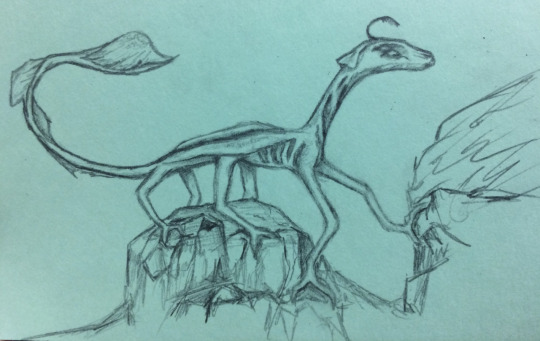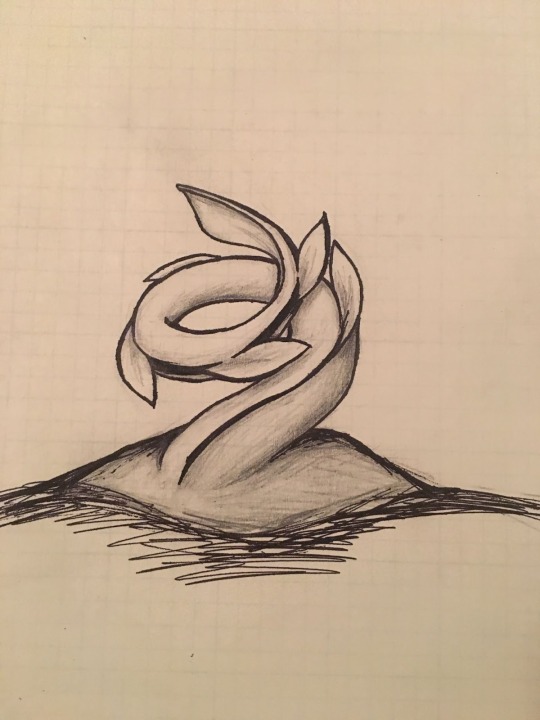#I'solan Lore Building
Explore tagged Tumblr posts
Text
I'sola - Physical Descriptions/Visuals
Image 1 (Below). Were you to catch them awake, the I’sola would appear to be six-legged dragons, with stingray wings and green leaves littering their whip-like tail.
I’sola are generally a dark black-blue, with strips of phosphorescent yellow dug into their skin, winding in unique patterns for each one you meet, but always with brightly shining strips cut horizontally up their long necks.
But let's look a little closer.

See the Google Doc with additional formatting and higher quality images Here.
Image 2 (Below, Left). Their heads, snake-like in construction, have no mouth to speak of and barely-visible strips of mesh-like material indented into the sides of their snout in place of nostrils. Their four eyes more than make up for this visual lack. Two of them, blank and yellow, are nestled into each other on each side of their head, so large as to take up a near third of where their skulls would sit.
[Though these antennae are nearly identical between males and females of the species, they provide very different functions - the males’ giving off pollen, and the females’ collecting it.]
Just behind the antenna is a soft flexible frill, laying flat back against the I’sola’s neck. It, like the rest of the I’sola’s body, is mostly blue with patterns of yellow. This frill is slightly shaped like a crest of a triceratops, and it - along with the I’sola’s neck stripes and antennae - are used extensively in communication.


Image 3 (Above, Right). Here you can see the front view of an I’sola, the way that the neck stripes seem like carved wounds into their neck, and how their legs sprout from beneath their wings.
Image 4 (Below, Left). Though these large creatures seem like they would need a great amount of physical support, their torsos are not solid at all, but seem to be branches forming a facsimile of ribs, protecting something vital inside. That ‘something vital’ seems only to be present in half of the population: two large seeds nestled within inner roots. See [Life Cycle] post (not yet linked). They do not seem to breathe, and they make almost no sound as they walk, sometimes even using the reduced gravity of their home world to glide along with their stingray-like wings.


Each of their long spindly legs seem to be made up of bark-like segments, split at the joints. They each have the same general construction, but the two forelegs contain an extra joint in both the leg and the fingers. Their limbs each have a foot with three spread toes ending in wide shovel-like nails. In addition, the toes on the back four legs are slightly more flexible to allow for an easier grip as they navigate their rocky home.
Image 5, 6 (Above, Right). When moving about, they walk on slightly-raised toes, protecting a hole placed at the center of the bottom of their feet. When they lay down to sleep, they spread their limbs out around them and their toes out wide and flat, revealing this opening and allowing their roots to extend outward. These roots can then dig deep into the soil to collect nutrients while they rest.
Image 7 (Below, Left). As plant-based creatures, they need sunlight, water, carbon dioxide, and additional nutrients from the ground soil around the rivers to survive. I’sola usually gather what they need during the Ring, sleeping near the rivers with leaves pointed towards the Ring in the sky and looking like large, fern-covered rocks or vines spiraling up toward the sky. Nearly three quarters of their days are spent in this state.


Image 8 (Right). Their Life Cycle will be discussed later on, but here you can see a depiction of a young I’sola, growing out of the ground before it has gained mobility. I add this here to give a better understanding of how their tails might look.
#humans are weird#humans are space australians#humans are strange#I'sola#I'solan Lore Building#original species#aliens#aliens and humans#original fiction#my art#art#sketch#eyes#leaves#creatures#plants#physical description#alt text#alien species#Crash Landing#world building#biology#original story#image description#visuals#links
27 notes
·
View notes
Text


Diagram Glow-up lmao.
See My I'sola solar system descriptions and art here!
#2016 vs 2023#humans are weird#i'sola#Crash Landing#I'solan Lore Building#diagrams#gabi'sart#my art#science#google drawings#my unwritten aus
4 notes
·
View notes